#decrepitude
Text

Poésie urbaine.
22 notes
·
View notes
Text
The MASH x The West Wing crossover no one asked for
Senator Frank Burns (R-IN)
9 notes
·
View notes
Text
The only reason I haven't drawn revue starlight fanart is I psychologically haven't been able to clear the mental hurdle that lets me draw serious and dramatic art of a girl named Banana who has banana shaped hair
#that and the fact that my health is suffering and I'm in my decrepitude#i think of her often#revue starlight
41 notes
·
View notes
Text
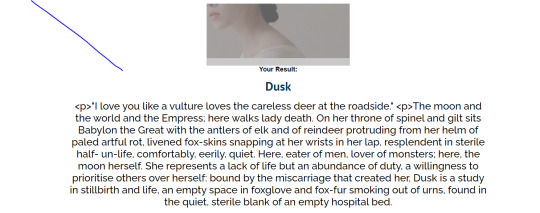

interesting to look back at my old writing and realise that yeah i have always been an enormous fan of commas. my god what a lot of fucking commas. son of a gun those are certainly some . those are some adjectives
the above is from like.... 2017 at minimum so it really does need to be updated as whereas each character is more or less the same in concept they have very different roles and different sets of flaws. if anything i think i’ve made them all much worse and Irreversibly Doomed over the years aahshsf.s i still really want to do this bit like a storybook which means that i have to. i have to draw them all and that require some serious levelling up on how to draw eldritch. entities because genuinely what the fuck is this
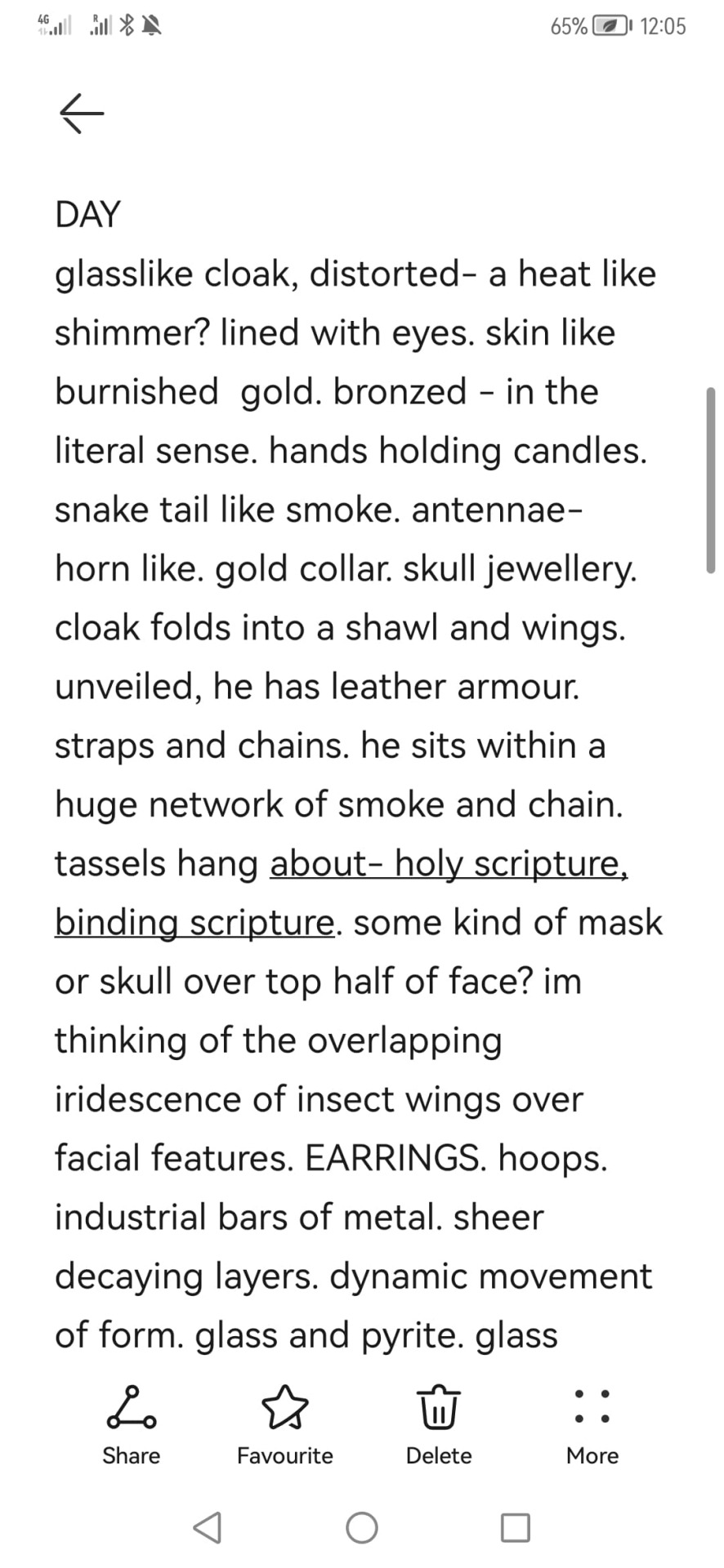
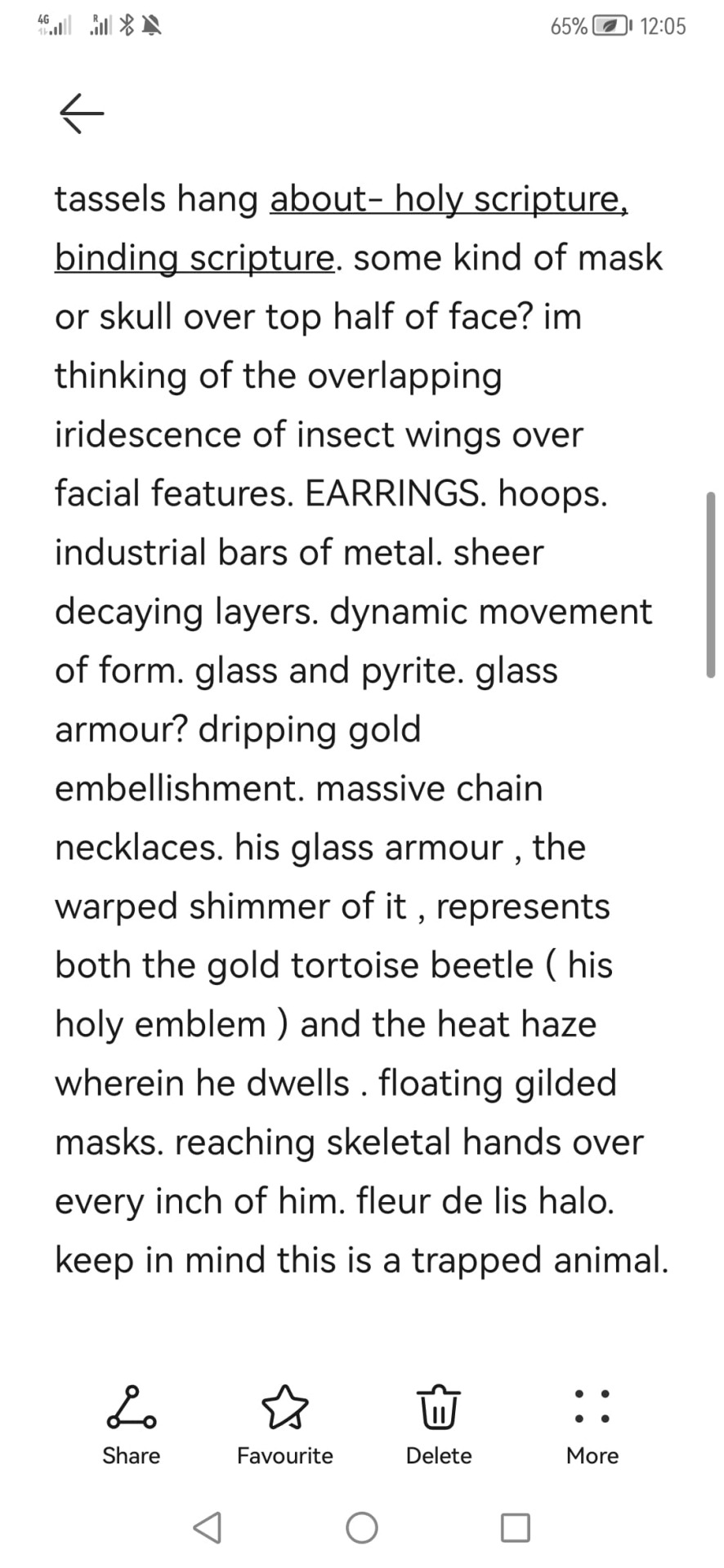
the only heterosexual couple in this whole shitshow is a firestorm abomination and his Bone Wife
#dellete#going through the results on this thing#i... really have got a lot more for day and dusk#husband and wife doomed lovers with their despot son#day's curse of cataclysmic collapse passed onto ofluxe.......#hmm#i dont think i was ever planning to bring day back into a physical body when i made this quiz#but new ch5 arc where he takes obeir's body is... fun bc it means i can redesign him as ye ol Biblical Angel#'keep in mind that this is a trapped animal' keep in mind that day is a plague and a ruin and a collapsing sun#all rotted rusted things compared to ofluxe who is comparatively styled very... ornately#very urrrrrr rococo#until he eventually rusts into the same decrepitude as his father#i think. i rlly need to find more creature artists to follow man i always#love seeing the Concepts#ok#okokok#no more trips down memory lane#i need#i need to study#AAAAAAAA I HAVE SO MUCH SHIT DUE I NEED TO STU D Y#my god the original conception of this was very cute and storybook#and then 2015-2017 was just. fucked. awful#but now finally. one crumb of character development#oh man i really need to#teach myself how to paint#ah jesus#ah jesus fucke
2 notes
·
View notes
Text

1 note
·
View note
Text
in GIDEON all the metaphors are like “rot. mold. decay.” this is to establish the decrepitude of canaan house and the visceral omnipresence of necromancy. however in HARROW all the metaphors are like “flesh. blood. organs.” this is because ianthe is there
1K notes
·
View notes
Text
“Será” que mudamos muito de lá pra cá? 1.2
Charles Darwin quando esteve no Recife, se impressionou com a brutalidade das pessoas e escreveu: “É uma terra de escravidão, portanto de decrepitude moral!” Messias Xavier – 15 nov 2022
Em sua travessia pelo norte fluminense, Darwin deparou-se também com os horrores da escravidão. Dois episódios lhe marcaram profundamente. Um deles aconteceu na Fazenda Itaocaia, em Maricá, a 60 km do Rio, no…

View On WordPress
#amar a Deus sobre todas as coisas e ao próximo como a si mesmo#amor à liberdade#brutalidade das pessoas#capitão do mato#Charles Darwin#decrepitude moral#em Maricá#Fazenda Itaocaia#Messias Xavier#país escravocrata#Recife#terra de escravidão
0 notes
Photo


Cette maison a connu des jours meilleurs, c'est évident. Délaissée, le temps a décidé de lui ôter toute sa splendeur. Pourtant, cette façade décrépie attire l'attention, elle possède un charme inexplicable qui la rend fascinante. Avec ses couleurs qui essaient tant bien que mal de revenir sur le devant de la scène, on croirait presque à l'oeuvre d'un peintre. On peut imaginer les années qui se sont écoulées depuis sa construction, les histoires qui se sont déroulées à l'intérieur, les drames qui ont marqué ses murs. C'est un témoignage de l'usure du temps qui lui donne un petit quelque chose de poétique. La beauté se cache souvent dans la décrépitude !
11 notes
·
View notes
Text

Art ref: Klimt, the Medicine. (It's not the whole painting, I wouldn't have had the time and I preferred a version focused on the character.)
I thought this one suited the Cardinal well, as the snake is very present in his attires.
In the original work, the bodies represent the different states of human suffering. For my version, I chose to stick with skeletal silhouettes, which can be understood either as a nod to the Dance Macabre, or as the image of death and decrepitude brought on by sin (the apple and all that, as we saw a character closely resembling Copia holding out the apple on a backdrop…wink wink)
I had to adapt the background a little by not placing the silhouettes in exactly the same place and not reproducing exactly the same motifs, it wouldn't have made sense.
Just a reminder: if you like my art, don't hesitate to support me on my Ko-fi page, which, as well as make me happy, will give you access to a step-by-step of my Goya remake, a traditional project that's already been going on since July.
#the band ghost#ghost#ghost fanart#ghost bc#copia#cardinal copia#illustration#digitalart#digital artist#digital painting#clip studio paint#reinterpretation of the original art by#gustav klimt#klimt#artists on tumblr
1K notes
·
View notes
Text







Back in August, my mother, my sister and I did a three day roadtrip to Lake Placid in New York State, where the 1932 and 1980 Winter Olympics were hosted. We hiked and visited Adirondack natural wonders the two first days, but because my health was starting to fail me on the second day, we kept the third one for visiting the Downton Abbey costume exhibition at the Lake Placid Center for the arts.
On our way to the exhibit, we passed by the Pines Inn, formerly known as the St. Moritz Hotel, a hotel built in 1907. I had wanted to stay at that hotel, but my mom refused, saying it was in poor shape and looked haunted on the hotel booking sites (she wasn't wrong, but I love that stuff, as you know). I still insisted for us to at least visit it, and we sure did NOT regret it. We stumbled upon one of the concierges (or new owners, correct me if you see this!), and he loved my outfit so much that he gave us a tour of the hotel, including in areas closed to guests. He told us that Albert Einstein and the Kennedys had been guests at the hotel, that there was n*de sunbathing on the roof in the 1930s and that a lot of the furniture was original. Sadly, after the 80s, the hotel slowly went into decrepitude and abandonment, and many things got stolen and damaged. The new owners are currently working hard to restore the hotel, and it's indeed a lot of work.
Outfit rundown
Dress: vintage Ingeborg (Pink House)
Velvet michiyuki: vintage
Hat: Rudsak with added brooch by Fuwari
Gloves: vintage
Shoes: old Clarks
Bag: second-hand Vivienne Westwood
Belt: thrifted
Big British stamp brooch: second-hand Jane Marple
Small marine cat stamp brooch: Via Carousel
Anchor and crest brooches: vintage
Earrings: old Dracolite
#fashion#vintage#vintage style#vintage fashion#1920's#1920's fashion#1920 fashion#20's fashion#retro fashion#pink house#jfashion#historybounding#old buildings#historical building#old hotel#lake placid#st. moritz#1900s architecture#antique#antique decor#long hairstyles#vintage hair#faux bob#vintage makeup#fanny rosie#fannyrosie
488 notes
·
View notes
Text

SANDCASTLE - Weather has not been kind to Lily's little sandcastle. The once mighty towers are quickly eroding away. You can see something shining back to you from what must have once been a vast underground catacomb network.
YOU - "Broken..."
KIM KITSURAGI - "The little castle?" The lieutenant smiles a little. "The reigning lord must have come upon some really tough times to let it slip in such decrepitude.
Kim silly goose moments... is he trying to cheer up Harry perhaps? Or just being silly about the sandcastle
(Note: yes I did correct the typo for screenreaders)
497 notes
·
View notes
Text
I’m gonna turn 32 in nearly a month and I personally like being in my 30s a lot. I am not self-conscious or concerned with this. I look 30something, I feel 30something, and I am totally cool with this. I don’t feel like 32 is old or past prime (heck, I’m not even old enough to run for President) and I am even more excited to turn 33 in 2025, the age that hobbits traditionally come of age.
I think a lot of the doom and gloom posts about being in your 30s are overblown at best and a load of hogwash at worst and it makes me sad to see my younger friends feel nervous about hitting that 30 year milestone.
Your body does not instantly fall apart the second you blow out your birthday candles. You don’t immediately lose interest in doing anything you thought was fun in your 20s. (Hint: if you do, that’s called depression).
But I do have one warning for you if you’re a young person swiftly approaching 30, one sign of aging that I never hear anyone talking about but that was, for me, the harbinger of coming decrepitude.
One day, you may look at Captain von Trapp, as portrayed by Christopher Plummer in The Sound of Music (1965) and go, “Okay, hmmm, I kinda get what Maria sees in him,” when you know for a fact you once saw him as “old” when you were younger. That’s the point of no return. That’s the crucial transition point from “hip youth” to “grownup.”
Then one day, you may realize that Christopher Plummer was the same age as many of your friends when he made that movie. (He was 35.) And that’s the moment you’ve fully crossed the bridge into maturity. The sooner you process that, the more you’ll enjoy the rest of your 30s. Bon voyage!
127 notes
·
View notes
Note
I come to you on my hands and knees (relevant to the topic right lol) begging for any and all info on Bane, Banites and how it all ties in with Gortash. I love you in advance. <3
Bane and His Cult
Alright, so after twelve and a half hours of research I still don’t fully feel like I have enough, but at a certain point I just need to get this out there, and if there is anything you – or anyone else – would like to see explored in more detail, please feel free to ask!
Note: I love getting asks like this! There is such a vast quantity of Realmslore that having some sort of specific focus for my deep-dives is a huge help, and knowing the topic is of interest to others is a huge motivator. I also greatly enjoy getting to put my training as a historian to work, as there is so much to interpret and archive alike.
As ever, these writeups will align with current 5e lore, and draw from 3.5e for additional supporting information. On rarer occasions – and always noted – I will reference 1e and 2e, but with the caveats that there is much more in those editions that is tonally dissonant with the modern conception of the Forgotten Realms, and thus generally less applicable.

We’ll begin with one of the most recent conclusive descriptions of Bane, from the 5e Sword Coast Adventurer’s Guide, an overview of the current world-state of, well, the Sword Coast:
Bane has a simple ethos: the strong have not just the right but the duty to to rule over the weak. A tyrant who is able to seize power must do so, for not only does the tyrant benefit, but so do those under the tyrant’s rule. When a ruler succumbs to decadence, corruption, or decrepitude, a stronger and more suitable ruler will rise.
Bane is vilified in many legends. Throughout history, those who favor him have committed dark deeds in his name, but most people don’t worship Bane out of malice. Bane represents ambition and control, and those who have the former but lack the latter pray to him to give them strength. It is said that Bane favors those who exhibit drive and courage, and that he aids those who seek to become conquerors, carving kingdoms from the wilderness, and bringing order to the lawless.¹
This gives us the briefest summation of what draws people to the Cult of Bane: the desire for power and control, often deriving from a sense that they lack exactly those two things. Bane is the quintessential deity of lawful evil, which – if you’ve read any of my previous posts on the sociology of the Nine Hells – bears a striking similarity to Baator itself, the realm of lawful evil, and the place where Enver Gortash spent at least a portion of his formative years.
The majority of the following excerpts derive from 3e, which went into far more detail on the specificities of the Faerûnian gods, including their dogmas, holy days, et cetera. One important point to note, however: any discussions of Bane’s scope of power are no longer accurate, as the time period in reference is about one hundred and twenty years before Baldur’s Gate 3 is set, at a time when Bane had just returned to life – and godhood – as nothing less than a greater god. By comparison, during Baldur’s Gate 3, he is a quasi-deity, having abandoned most of his previous godly power in exchange for the ability to directly meddle with Faerûn – forbidden to the gods by the overgod Ao – and gambling that he would be able to regain his lost power and prestige in so doing.²
The dogma of Bane – that is, the core tenets and philosophies that his followers seek to emulate – is as follows:
Serve no one but Bane. Fear him always and make others fear him even more than you do. The Black Hand always strikes down those that stand against it in the end. Defy Bane and die — or in death find loyalty to him, for he shall compel it. Submit to the word of Bane as uttered by his ranking clergy, since true power can only be gained through service to him. Spread the dark fear of Bane. It is the doom of those who do not follow him to let power slip through their hands. Those who cross the Black Hand meet their dooms earlier and more harshly than those who worship other deities.³
Even were there nothing else to go off of, this would tell us a great deal about the group dynamics of any followers of Bane, whether established church or fragmented cult. Just as in the Hells, hierarchy is everything to proponents of lawful evil. Any cult of Bane would have a strict order to its power structure, and there would be limited – practically nonexistent – tolerance for any questioning or insubordination of that order. To the minds of Banites, such is simply the natural and superior ordering of the world. These interactions are detailed below:
Within the church, the church hierarchy resolves internal disputes through cold and decisive thoughts, not rash and uncontrolled behavior. Bane’s clerics and worshipers try to assume positions of power in every realm so that they can turn the world over to Bane. They work subtly and patiently to divide the forces of their enemies and elevate themselves and the church’s allies over all others, although they do not fear swift and decisive violent action to help achieve their aims.³
The manner of tyranny that Bane holds to is similarly calculated – he is not interested in mere shows of force, but rather in insidious plots that twist and make use of existing rule of law to legitimize tyranny wherever possible. A social tide operated ostensibly within the laws of the land is far more troublesome to fight back against than a simple army.⁴
As far as specific ritual and day-to-day workings of the cult, some can be evidenced here, in broad strokes:
Bane’s clerics pray for spells at midnight. They have no calendar-based holidays, and rituals are held whenever a senior cleric declares it time. Rites of Bane consist of drumming, chanting, doomful singing, and the sacrifice of intelligent beings, who are humiliated, tortured, and made to show fear before their death by flogging, slashing, or crushing.³
In this sense, rituals seem most likely to be used as a display of power and a test of subservience, leaving lower-ranked members of the cult at the whims of their superiors, expected – as noted previously – to attend to their commands with the same alacrity they would use were Bane himself to speak. The rites themselves are designed to reinforce and glorify the primary aspects of their god’s domain: the tyranny of forcing submission and pain from the weak.
Faiths & Pantheons, published a year after the Campaign Setting supplement, provides a similar description of the rituals of the cult of Bane, along with some intriguing and flavorful additions (noted in bold for ease of comparison):
Their religion recognizes no official holidays, though servants give thanks to the Black Hand before and after major battles or before a particularly important act of subterfuge. Senior clerics often declare holy days at a moment's notice, usually claiming to act upon divine inspiration granted to them in dreams. Rites include drumming, chanting, and the sacrifice of intelligent beings, usually upon an altar of black basalt or obsidian.”⁴
As, in the “present day” of Baldur’s Gate 3, Bane has lost much of his foothold on power and his Faith’s old domains, the specifics of architecture of Banite keeps are no longer quite so relevant. However, in times past, when his Faith worked far more openly and held much greater power, the philosophy of Bane was expressed through the architecture of his churches and strongholds:
Tall, sharp-cornered stone structures featuring towers adorned with large spikes and thin windows, most Banite churches suggest the architecture of fortified keeps or small castles. Thin interior passageways lead from an austere foyer to barrackslike common chambers for the lay clergy, each sparsely decorated with tapestries depicting the symbols of Bane or inscribed with embroidered passages from important religious texts.⁴
The social capital of a Faith – a broad term used to encapsulate all followers of a single deity – is often heavily intertwined with the power of its god, a mutualistic relationship that runs in both directions. More social weight behind the Faith means its god’s name and will is conveyed to more people, some or many of whom might apportion some worship or act in alignment with that god and empower them by so doing. More power for the god means more divine actions that can bolster their own image and the reach of their clergy. At its height in the late 1300s, the Faith of Bane was one of the most prominent and powerful, with comparable might to that of a small kingdom.⁵
Something that is important to bear in mind in a setting such as the Forgotten Realms, not only polytheistic, but an environment where the gods being worshiped are demonstrably existent, is that the followers of evil gods are not likely to be obtrusive with the less savory aspects of their dogma. Not only would that, in the majority of cases, do more harm than good to their deity’s long term goals, in the words of Elminster:
A dead foe is just that: dead, and soon to be replaced by another. An influenced foe, on the other hand, is well on the way to becoming an ally, increasing the sway of the deity.⁶
All of this aligns with what we see of the Cult of Bane and its operation in Baldur’s Gate 3. While it does not have the same sway and might behind it as it did a hundred years before, through manipulation of law and carefully applied pressure – of whatever form most likely to yield the desired results, be it threats, bribery, blackmail, or use of hostages – Gortash has enacted a steel web of delicate, ensnaring tyranny across the entire city.
We can even find present-day expressions of the interactions of the cult members, and find that they hold true to what their forebears experienced, further proof of the consistency of lawful evil. A personal note found on the body of a dead Banite guard at the Steel Watch Foundry calls the Black Gauntlet in charge of the Foundry Lab, Hahns Rives, a “disgrace to the Tyrant Lord”, and notes the writer’s intent to “compile a list of Rives’ shortcomings for the Overseers.”⁷ These shortcomings include:
1. Rives failed to reprimand Polandulus for making jokes about Lord Gortash!
2. Rives missed the morning mass to Bane - twice!
3. Rives didn't punish Gondian Ofran when she missed her gyronetics quota merely because she'd lost a finger that day in the punch press.⁷
We can see evidenced here the constant scheming for position and recognition consistent with this manner of lawful evil hierarchy. Both devils and Banites orient their day-to-day lives around how to prove themselves to their superiors, while also undercutting them at any chance they have to prove their own superiority, with hopes of being raised above them.
This is only reinforced further by another text found within the Steel Watch Foundry, Bane’s Book of Admonitions. Its text is not written out for us, but described as such:
A book of adages and precepts for Banites, providing the basic tenets of worship of the Lord of Tyranny, with suggested prayers for common situations. The heart of the book is Bane's Twelve Admonitions, a dozen rules for proper Banite conduct, with punishments specified for failure to comply. The book opens easily to a page with two of Bane's most popular admonitions, number six, the Reprimand for Leniency, and number seven, the Rebuke for False Compassion.⁸
The most likely scenario is that this book was used by the “Overseers” referenced by the anonymous Banite writing of Rives above. The exact position of the Overseers is not made clear, but from context and knowledge of Banite hierarchy, we can infer that they inhabit a place in the hierarchy above both the guard and Rives himself, and that their role is to ensure all those below them uphold the tenets of Bane at all times, never losing sight of his will.
In that context, it makes sense that they would both have a book of specific punishments for specific infractions – rule of law, after all – and that, given the attempted report on Rives, punishments (“admonitions”) for the crimes of leniency and false compassion – and all compassion is false when your conception of the world does not allow for its existence – would be those most referenced. It would be incredibly important to the unity of the cult, as well as to Gortash’s plans, to harshly punish any observed leniency or break from Bane’s law among members of the cult.
Not only would failure to control the situation at the Foundry potentially spell failure for the schemes of Bane’s Chosen, any unpunished step out of line by members of the cult would be seen as tempting others to do the same, a trickle of dissent quickly becoming a flood. Better to ensure that all adherents live in merited fear of the consequence of failure.
After all, it is said of Bane himself: “He has no tolerance of failure and seldom thinks twice about submitting even a loyal servant to rigorous tortures to ensure complete obedience to his demanding, regimented doctrine.”⁴
And, in an appropriately lawful hierarchy, the same rule must apply from the bottom, to the top.

¹ Sword Coast Adventurer’s Guide. 2014. p. 26.
² Descent into Avernus. 2019. p. 231
³ Forgotten Realms Campaign Setting 3E. 2001. pp. 237-8
⁴ Faiths & Pantheons. 2002. pp. 15-16.
⁵ Forgotten Realms Campaign Setting 3E. 2001. p. 93
⁶ Ed Greenwood Presents: Elminster’s Guide to the Forgotten Realms. 2012. pp. 135-6.
⁷ Rives’ Failures as a Banite. Baldur’s Gate 3. In-Game Text.
⁸ Bane’s Book of Admonitions. Baldur’s Gate 3. In-Game Text.
#voidling speaks#asked and answered#realmslore#meta#my meta#bg3 meta#bg3#bg3 gortash#bg3 bane#enver gortash#bane#baldur's gate 3#forgotten realms#cult of bane#d&d 5e#d&d 3.5
111 notes
·
View notes
Text
HI. IT'S ME AGAIN. YA BITCH. AND YOU KNOW WHAT THAT MEANS. OH YEAH WE'RE TALKING ABOUT GHOST COSTUMES.
Well... One Ghost costume in particular. Because I've talked at great lengths about how the costumes are made and what they're made out of but I haven't talked much, if at all, about the inspiration behind them. So today we're gonna take a look at Papa's Kaiserion costume.
Impera, Ghost's fifth studio album, builds itself on the themes of the rise and fall of empires. Kaiserion, the first song of the album with lyrics, leans heavily and explicitly on those themes. It makes sense, as being also the first song played live during this era, that Papa's outfit would reflect that empirical meaning.

Copia has always been so interesting to me in terms of stage costumes as he never really tried to fit into the role carved by his predecessors. The band's image, before Terzo was relieved of his Papal duties (and his head), relied on Satanism and depicting themselves as an opposite for Christianity. Taking inspiration into religious costumes and giving them a stylish twist à la Satan. Terzo started this trend of diverging from this image but he only had one stage outfit that wasn't his robes. Copia has had several from the very start.
This one costume is no exception. You will find Satanic and occultist symbols in the embroidery on his vest but it's not trying to be a religious garment in any way, shape or form. It rather reminds me of French military uniforms from the late 1700s to the late 1800s.

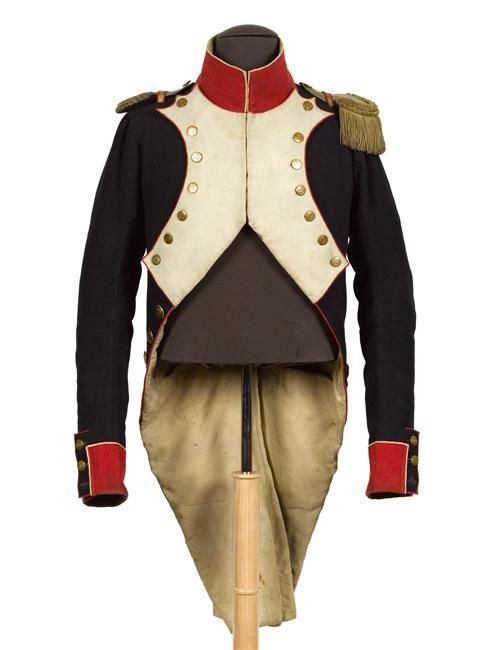
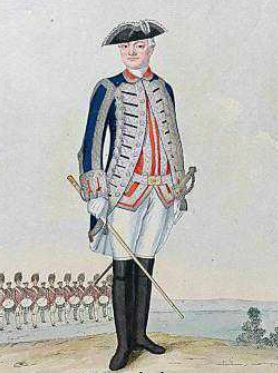
Obviously it's not a perfect replica of any historical uniform but I still find the comparison fascinating and I have a deep appreciation for the imagery it creates. It leads us straight into the atmosphere created by the song and it infers on Copia a sense of authority fitted for the meaning of the album. For the span of those 5 minutes of the concert, he's not just a spiritual leader, he's a ruler commanding an army.
That sentiment is aided by one of my favourite details. Epaulettes were often used to mark stature on uniforms. Not only if you had them but what they looked like. You didn't think I was gonna make a whole post about Papa and not mention the ghouls once, were you?


Not only is the overall construction of Papa's jacket made to be more imposing than the ghouls, his golden epaulettes imply a greater status, a higher rank.
I would also like to point out the state of the jacket. Which of course, matches the decrepitude of the pants he wears for the entire concert. To me, it implies a meaning hidden in the concept of the album itself. The military inspired jacket paints him as a commander ready for conquest, ready to go to war for him Empire. To me, all that intentional distressing says "this is what it'll look like once we fall, this is what it'll look like when the Empire fails."
All of this really makes me question the fate awaiting Copia now that this era is over. "The empire has been built." it feels like half of the prophecy fulfilled. We're yet to see it fall, but the fall was promised.
Aight didn't mean to get all ominous on ya at the end but oh well 😅😅😅 that's all for me today! Thank you and good night!
#the band ghost#ghost bc#papa emeritus the fourth#papa emeritus iv#papa copia#copia#impera#impera era#meerkat talks about ghost costumes#nameless ghoul#nameless ghouls
138 notes
·
View notes
Text

عَنْ أَبِي الْيَسَرِ، أَنَّ رَسُولَ اللَّهِ صلى الله عليه وسلم كَانَ يَدْعُو " اللَّهُمَّ إِنِّي أَعُوذُ بِكَ مِنَ الْهَدْمِ وَأَعُوذُ بِكَ مِنَ التَّرَدِّي وَأَعُوذُ بِكَ مِنَ الْغَرَقِ وَالْحَرَقِ وَالْهَرَمِ وَأَعُوذُ بِكَ أَنْ يَتَخَبَّطَنِي الشَّيْطَانُ عِنْدَ الْمَوْتِ وَأَعُوذُ بِكَ أَنْ أَمُوتَ فِي سَبِيلِكَ مُدْبِرًا وَأَعُوذُ بِكَ أَنْ أَمُوتَ لَدِيغًا " . حديث صحيح - سنن أبي داوود والنسائي حديث ١٥٥٢ - ٥٥٣٢
Narrated AbulYusr: The Messenger of Allah (peace be upon him) used to supplicate: "O Allah, I seek refuge in Thee from my house falling on me, I seek refuge in Thee from falling into an abyss, I seek refuge in Thee from drowning burning and decrepitude. I seek refuge in Thee from the devil harming me at the time of my death, I seek refuge in Thee from dying in Thy path while retreating, and I seek refuge in Thee from dying of the sting of a poisonous creature." Hadith Sahih - Sunan Abi Dawud 1552 In-book reference : Book 8, Hadith 137 \\ Sunan an-Nasa'i 5532 In-book reference : Book 50, Hadith 105
(مِنَ الْهَدْمِ) بِسُكُونِ الدَّالِ وَهُوَ سُقُوطُ الْبِنَاءِ وَوُقُوعُهُ عَلَى الشَّيْءِ
وَرُوِيَ بِالْفَتْحِ وَهُوَ اسْمُ مَا انْهَدَمَ مِنْهُ ذَكَرَهُ الطِّيبِيُّ (مِنَ التَّرَدِّي) أَيِ السُّقُوطِ مِنْ مَكَانٍ عَالٍ كَالْجَبَلِ وَالسَّطْحِ أَوِ الْوُقُوعِ فِي مَكَانٍ سَافِلٍ كَالْبِئْرِ (مِنَ الْغَرَقِ) بِفَتْحَتَيْنِ مَصْدَرُ غَرِقَ فِي الْمَاءِ (وَالْحَرَقِ) بِالتَّحْرِيكِ أَيْضًا أَيْ بِالنَّارِ وَإِنَّمَا اسْتَعَاذَ مِنَ الْهَلَاكِ بِهَذِهِ الْأَسْبَابِ مَعَ مَا فِيهِ مِنْ نَيْلِ الشَّهَادَةِ لِأَنَّهَا مِحَنٌ مُجْهِدَةٌ مُقْلِقَةٌ لَا يَكَادُ الْإِنْسَانُ يَصْبِرُ عَلَيْهَا وَيَثْبُتُ عِنْدَهَا (وَالْهَرَمِ) أَيْ سُوءِ الْكِبَرِ الْمُعَبَّرِ عَنْهُ بِالْخَرَفِ وَأَرْذَلِ الْعُمُرِ لَكَيْلًا يَعْلَمَ بَعْدَ عِلْمٍ شَيْئًا (أَنْ يَتَخَبَّطَنِيَ الشَّيْطَانُ)أَيْ إِبْلِيسُ أَوْ أَحَدُ أَعْوَانِهِ
قِيلَ التَّخَبُّطُ الْإِفْسَادُ وَالْمُرَادُ إِفْسَادُ الْعَقْلِ وَالدِّينِ وَتَخْصِيصُهُ بِقَوْلِهِ (عِنْدَ الْمَوْتِ) لِأَنَّ الْمَدَارَ عَلَى الْخَاتِمَةِ
وَقَالَ الْقَاضِي أَيْ مِنْ أَنْ يَمَسَّنِيَ الشَّيْطَانُ بنزعاته الَّتِي تَزِلُّ الْأَقْدَامَ وَتُصَارِعُ الْعُقُولَ وَالْأَوْهَامَ
وَأَصْلُ التَّخَبُّطِ أَنْ يَضْرِبَ الْبَعِيرُ الشَّيْءَ بِخُفِّ يَدِهِ فيسقط
قال الخطابي استعاذته عليه السلام مِنْ تَخَبُّطِ الشَّيْطَانِ عِنْدَ الْمَوْتِ هُوَ أَنْ يَسْتَوْلِيَ عَلَيْهِ الشَّيْطَانُ عِنْدَ مُفَارَقَتِهِ الدُّنْيَا فَيُضِلَّهُ وَيَحُولَ بَيْنَهُ وَبَيْنَ التَّوْبَةِ أَوْ يُعَوِّقَهُ عَنْ إِصْلَاحِ شَأْنِهِ وَالْخُرُوجِ مِنْ مَظْلِمَةٍ تَكُونُ قَبْلَهُ أو يؤسه مِنْ رَحْمَةِ اللَّهِ تَعَالَى أَوْ يَكْرَهُ الْمَوْتَ وَيَتَأَسَّفُ عَلَى حَيَاةِ الدُّنْيَا فَلَا يَرْضَى بِمَا قَضَاهُ اللَّهُ مِنَ الْفَنَاءِ وَالنَّقْلَةِ إِلَى دَارِ الْآخِرَةِ فَيُخْتَمُ لَهُ بِسُوءٍ وَيَلْقَى اللَّهَ وَهُوَ سَاخِطٌ عَلَيْهِ
وَقَدْ رُوِيَ أَنَّ الشَّيْطَانَ لَا يكون في حال أشد على بن آدَمَ مِنْهُ فِي حَالِ الْمَوْتِ يَقُولُ لِأَعْوَانِهِ دُونَكُمْ هَذَا فَإِنَّهُ إِنْ فَاتَكُمُ الْيَوْمَ لَمْ تَلْحَقُوهُ بَعْدَ الْيَوْمِ
نَعُوذُ بِاللَّهِ مِنْ شَرِّهِ وَنَسْأَلُهُ أَنْ يُبَارِكَ لَنَا فِي ذَلِكَ الْمَصْرَعِ وَأَنْ يَخْتِمَ لَنَا وَلِكَافَّةِ الْمُسْلِمِينَ وَأَنْ يَجْعَلَ خير أيامنا لِقَائِهِ انْتَهَى
(أَنْ أَمُوتَ فِي سَبِيلِكَ مُدْبِرًا) أَيْ مُرْتَدًّا أَوْ مُدْبِرًا عَنْ ذِكْرِكَ وَمُقْبِلًا عَلَى غَيْرِكَ
وَقَالَ الطِّيبِيُّ أَيْ فَارًّا وَتَبِعَهُ بن حَجَرٍ الْمَكِّيُّ وَقَالَ إِدْبَارًا مُحَرَّمًا أَوْ مُطْلَقًا
قِيلَ إِنَّ ذَلِكَ مِنْ بَابِ تَعْلِيمِ الْأُمَّةِ وإلا فرسول الله لَا يَجُوزُ عَلَيْهِ التَّخَبُّطُ وَالْفِرَارُ مِنَ الزَّحْفِ وَغَيْرُ ذَلِكَ مِنَ الْأَمْرَاضِ الْمُزْمِنَةِ (أَنْ أَمُوتَ لَدِيغًا) فَعِيلٌ بِمَعْنَى مَفْعُولٍ مِنَ اللَّدْغِ وَهُوَ يُسْتَعْمَلُ فِي ذَوَاتِ السُّمِّ مِنَ الْعَقْرَبِ وَالْحَيَّةِ وَنَحْوِهِمَا . عون المعبود شرح سنن أبي داود
#حديث#أحاديث نبوية#رسول الله صلى الله عليه وسلم#حديث الرسول#دعاء#صلى الله عليه وسلم#الرسول صلى الله عليه وسلم#محمد صلى الله عليه وسلم#النبي محمد صلى الله عليه و آله وسلم#اللهم صل وسلم على نبينا محمد#الهدم#التردي#الهرم#زلزال#غرق#اعصار#أدعية#hadith#sunnah#ahadeth#islam#hadeth#muslim#prophet muhammad#prophet mohammed#sunna#hadith sahih#refuge#oh allah#allah
178 notes
·
View notes
Text
twenty yr age gap this, and twenty yr age gap that. bestie, some of the men I like are in their fifties or sixties . let’s get it together, we’ve entered our peepaw era. we’re in that old man decrepitude age.
77 notes
·
View notes